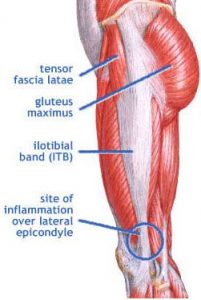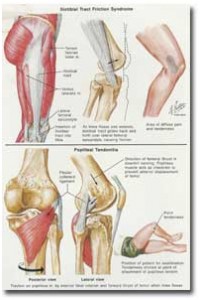Iliotibial Band Syndrome (ITBS) is a common running knee injury. This article will help you identify ITBS symptoms, causes, and treatment options.
 What is Iliotibial Band Syndrome (ITBS)?
What is Iliotibial Band Syndrome (ITBS)?
The Iliotibial band is a thick tendon that inserts on the outside of your knee. The function of the Iliotibial band is to help slow movement and torque at your knee during impact. Iliotibial band syndrome is a common cause of knee pain in runners. The cause is repetitive trauma to the Iliotibial band insertion on the outside of the knee resulting in tendonitis and severe lateral knee pain while running. Eventually this condition will result in degeneration of the tendon and progress to a condition called tendonosis. This means there will be excessive tightness due to abnormal scar formation and may become a source of chronic knee pain for the runner.
Iltiotibal Band Syndrome (ITBS) Symptoms and Causes
The classic sign of Iliotibial band syndrome is pain in the outside of their knee that gets progressively worse while they are running. The pain will eventually cause them to stop and may cause lasting pain that hurts worse while walking up and down stairs.
A typical runner will wait a few days until the pain is gone and try to run again with the pain appearing during their run. This process is repeated over again until the runner can not run without severe knee pain.
Runners with very low arches and runners high arches are predisposed to developing Iliotibial band syndrome. Other anatomical risk factors include overpronation, anatomical leg length discrepancy, and excessive torsion at the knee, bow-legs, knock-knees and muscle imbalances. This condition is closely associated with running, therefore most runners with Iliotibial band syndrome can swim, bike, use the elliptical trainer or do free weights without pain. The condition is usually associated with an excessive increase in running mileage, new runners or an experienced runner returning from a layoff.
Iliotibial Band Syndrome (ITBS) Diagnosis
Examination of a runner with Iliotibial band syndrome may reveal tenderness over the outside of the knee and an increase in pain while running. A proper biomechanical evaluation should be made to check for overpronation, low arches, leg length discrepancy and other factors that may alter the runner mechanics. X-rays and MRI’s are usually not necessary although in difficult cases an MRI is warranted. Other causes of outside knee pain that must be looked for are lateral collateral ligament sprain, meniscus tears, synovial plica, runner’s knee or chondromalacia, patella tracking errors, knee bursitis and other uncommon causes.
Ilitotibial Band Syndrome (ITBS) Treatment
Treatment for Iliotibial band syndrome includes rest from running, strengthening of the hip and knee muscles, stretching of the hip and knee muscles, changing shoes, the use of orthotics and sometimes using an Iliotibial band compression brace. Early recognition by the runner, rest and proper treatment can result in a dramatically shortened duration of Iliotibial band syndrome. Most cases of Iliotibial band syndrome we treat get better within 4-6 weeks as opposed to 12-24 months reported by many runners!
Other forms of exercise such as biking, swimming, elliptical and weight training do not appear to aggravate Iliotibial band syndrome. It may be difficult but runner’s must stop running and allow the Iliotibial band to heal.
Changing shoes can be effective. Many runners’ report that by changing shoes their Iliotibial band syndrome was alleviated. If you currently have Iliotibial band syndrome it is probably a good idea to experiment with new running shoes. If you are currently wearing stability shoes try a neutral shoe. If you are currently wearing a neutral shoe try changing to a stability shoe or add stability over the counter orthotic. If you are in San Diego go to Milestone Running Shop in North Park to get your shoes.
Both over the counter orthotics and custom orthotics have been found to be superior to taking NSAID’s (non-steroidal anti-inflammatory drugs) and cortisone injections. In my experience orthotics have been useful in about 20-30% of Iliotibial band syndrome patients I have treated. Over the counter orthotics such as SUPERFEET can be useful and cost roughly $35. Sometimes custom orthotics are necessary. At SDRI custom orthotics are $367 or $500 for 2 pair.
There is always typical medical treatment of plantar fasciitis. You start by taking Ibuprofen (did anyone ever tell you….Iliotibial band syndrome is an Ibuprofen deficiency?), when that does not work maybe they send you to physical therapy, (my grandma could do those exercises!), now the cortisone shot is give (man that hurt! How do you know they simply did not miss?) Then surgery is offered. Do you really want surgery and all the complications that go with it?
Here are recommendations for Iliotibial Band Syndrome (ITBS):
- Get a good doctor. One who runs and specializes in manual treatment is preferable. Proper treatment will fix this condition.
- Correct training errors. This translates to “Stop running and irritating your Iliotibial band!”
- Change shoes and change your activity for the meantime from running to biking, swimming, elliptical or weights.
- Undertake a proper stretching and strengthening program, immediately.
- Get orthotics.
- Get an Iliotibial band compression strap. This will act as a “band-aid” when you return to running.
Call (858) 268-8525 for an appointment or email info@sdri.net for more info.

